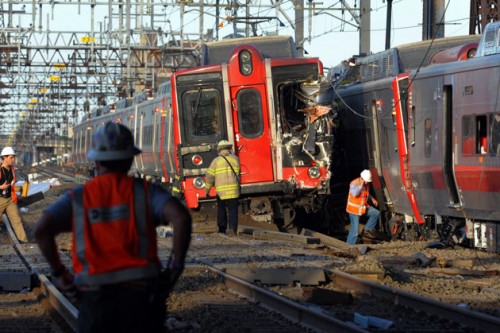Probe into Conn. train crash giving way to cleanup

BRIDGEPORT, Conn. (AP) Investigators will look closely at a broken section of rail to see if it is connected to the commuter train derailment and collision outside New York City that left dozens injured, as the focus begins to shift toward cleanup and rebuilding ahead of challenging times for travelers and commuters along the Northeast Corridor.
A member of the National Transportation and Safety Board said Saturday that a fractured section of rail is of substantial interest to investigators and a portion of the track will be sent to a lab for analysis. Officials also said Saturday the incident was not the result of foul play.
It's not clear if the accident caused the fracture or if the rail was broken before the crash, the NTSB's Earl Weener said. He emphasized the investigation was in its early stages and said he won't speculate on the cause of the derailment. Data recorders on board are expected to provide the speed of the Metro-North trains at the time of the crash and other information, he said.
Seventy-two people were sent to the hospital Friday evening after a Metro-North train heading east from New York City derailed and was hit by a train heading west from New Haven. Most have been discharged.
Officials earlier described devastating damage and said it was fortunate no one was killed.
"I feel that we are fortunate that even more injuries were not the result of this very tragic and unfortunate accident," said U.S. Sen. Richard Blumenthal, who visited several patients in the hospital.
The crash damaged the tracks and threatened to snarl travel in the Northeast. The crash also caused Amtrak to suspend service between New York and Boston.
Blumenthal called the damage "absolutely staggering,"
Attention is slowly shifting to the cleanup, restoration and the upcoming work week.
Metro-North said train service will remain suspended between South Norwalk and New Haven until further notice. Railroad officials said rebuilding the two tracks and restoring train service "will take well into next week."
NTSB investigators arrived Saturday and are expected to be on site for seven to 10 days. They'll look at the brakes and performance of the trains, the condition of the tracks, crew performance and train signal information, among other things.
When the NTSB concludes the on-site phase of its investigation, Metro-North will begin to remove the damaged rail cars and remaining debris. The process requires specialized, heavy equipment that was expected to be in place Sunday, officials said. Only after the damaged train cars have been removed can Metro-North begin the work of rebuilding the damaged tracks and overhead wires.
"It is a significant undertaking that could take days to complete," MTA said in a statement.
The NTSB has allowed Metro-North to begin removing some of the track and wire from the scene.
Gov. Dannel P. Malloy said commuters should make plans for alternative travel through the area and urged them to consult the state Department of Transportation website for information.
Bridgeport Mayor Bill Finch said the disruption caused by the crash could cost the region's economy millions of dollars.
About 700 people were on board the Metro-North trains when one heading east from New York City's Grand Central Terminal to New Haven derailed at about 6:10 p.m. just outside Bridgeport, transit and Bridgeport officials said. Passengers described a chaotic, terrifying scene of crunching metal and flying bodies.
A spokeswoman for St. Vincent Medical Center said late Saturday that 46 people from the crash were treated there, with six of them admitted. All were in stable condition, she said.
A Bridgeport Hospital spokesman said 26 people from the crash were treated there, with three of them admitted. One was in critical condition and two were in stable condition, he said. The other 23 were released.
The MTA operates the Metro-North Railroad, the second-largest commuter railroad in the nation. The Metro-North main lines the Hudson, Harlem, and New Haven run northward from New York City's Grand Central Terminal into suburban New York and Connecticut.
The last significant train collision involving Metro-North occurred in 1988 when a train engineer was killed in Mount Vernon, N.Y., when one train empty of passengers rear-ended another, railroad officials said.
___
Associated Press writers Michael Melia in Hartford, Conn., Susan Haigh in Fairfield, Conn., and Verena Dobnik in New York City contributed to this report.
0 comments :
Post a Comment